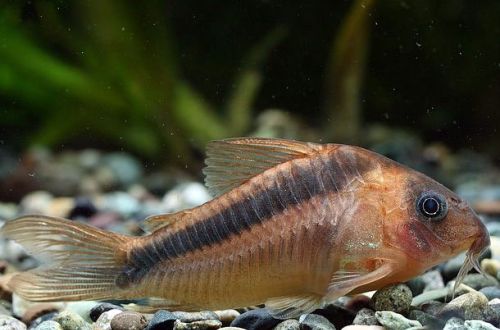
Parosfromenus adorned
Parosphromenus ornaticauda, scientific name Parosphromenus orticauda, belongs to the family Osphronemidae. This fish is often found on sale, however, its maintenance is associated with a number of difficulties, so it is not recommended for beginners.

Contents
Habitat
It comes from Southeast Asia from the Indonesian part of the island of Borneo, the province of West Kalimantan. Inhabits peat bogs in the basins of the Kapuas and Pavan rivers. A typical biotope is a shallow body of water, located in the middle of a dense tropical forest, poorly lit by the sun. The bottom is covered with a thick layer of fallen plant material, the decomposition of which releases humic acids and other tannins, coloring the water a rich brown color.
Brief information:
- The volume of the aquarium – from 30 liters.
- Temperature – 22-28°C
- Value pH — 3.0–6.5
- Water hardness – 1–5 dGH
- Substrate type – any dark
- Lighting – subdued
- Brackish water – no
- Water movement – little or no
- The size of the fish is about 3 cm.
- Food – live or frozen food
- Temperament – peaceful
- Content – in a group of relatives or with other small species
Description
Adult individuals reach a length of no more than 3 cm. The fish fully justify their name “decorated”, thanks to the contrasting pattern on the body and fins. The lower part of the body is blackish-brown, the upper part is lighter. At the same time, during the spawning season, the light part darkens, practically merging with the bottom. The tail has a bluish-white edge, the inner part is black with a wide red stripe. The rest of the fins are dark with light edging. The coloration of males and females is almost identical.
Food
Prefers live or frozen food. The basis of the diet will be small invertebrates such as brine shrimp, daphnia, bloodworms, mosquito larvae, etc. It is noted that dry food is usually not accepted.
Maintenance and care, arrangement of the aquarium
The optimal size of the aquarium for one or two fish starts from 20-30 liters. In the design, it is desirable to provide for a large number of shelters, for example, from a combination of snags and thickets of plants, including floating ones. The lighting is subdued, so you should choose from among the shade-loving varieties. Any dark soil. A layer of dried leaves of some trees is usually placed on top of the substrate, previously soaked so that they do not float. The leaves are not only part of the natural decoration, but also a means of giving the water a chemical composition characteristic of the one in which fish live in nature. More details in a separate article “The leaves of which trees can be used in an aquarium.”
However, the design can be arbitrary. Some breeders do not use soil at all for ease of maintenance, but use fragments of PVC pipes, ceramic pots turned on their side, and other decorative items as shelters.
The long-term maintenance of Parosfromenus embellished depends on maintaining a stable aquatic environment within an acceptable range of temperatures and hydrochemical values. The latter can be problematic for beginner aquarists, as reaching low pH and dGH values will require either a reverse osmosis system or traditional soft water methods. It is important to ensure gentle filtration without excessive water movement. A simple airlift filter with a sponge is often useful.
Behavior and Compatibility
There is competition between males for the attention of females, which intensifies during the spawning season. However, rivalry rarely goes beyond a “show of strength”, so several males are allowed in one aquarium. Peaceful, get along well with other non-aggressive species of comparable size.
Breeding / breeding
If decorated Kupanus are in a suitable environment for themselves and receive a balanced diet, then this creates favorable conditions for spawning. With the onset of the breeding season, males acquire a uniform dark color, as already mentioned above. They occupy a site at the bottom, in the center of which there is some kind of shelter, and proceed to courtship. Sometimes a nest of air bubbles is built in advance in a shelter. When the female accepts signs of attention, spawning begins. The fish are tightly pressed against each other, occupying an almost vertical position with their heads down. At a certain moment, a portion of eggs is released and immediately fertilized. All eggs are carefully placed by the parents in the shelter. At the end of spawning, the female swims away, and the male remains to guard the clutch. He is with his offspring until the fry that appear begin to swim on their own. The whole process takes about a week, the loan male loses interest in them. The fry can grow safely with their parents without fear of being eaten. However, if other species live in the aquarium, then cases of predation cannot be avoided. In this case, the juveniles should be moved to a separate tank.
Fish diseases
A well-established biological system, a balanced diet and the absence of stressful situations (for example, being chased by aggressive fish) are the best guarantee of maintaining health. When the first signs of an illness appear, first of all, attention should be paid to these three factors, perhaps there was a deviation in one of them. As a rule, solving the problem leads to self-healing. However, if the immune system fails, you will have to resort to medical treatment. Read more about symptoms and treatments in the Aquarium Fish Diseases section.





